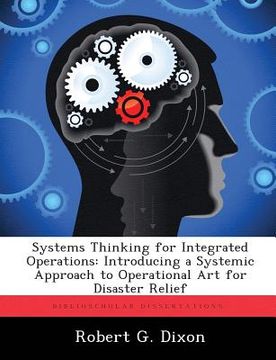Compartir
Systems Thinking for Integrated Operations: Introducing a Systemic Approach to Operational Art for Disaster Relief (en Inglés)
Robert G. Dixon
(Autor)
·
Biblioscholar
· Tapa Blanda
Systems Thinking for Integrated Operations: Introducing a Systemic Approach to Operational Art for Disaster Relief (en Inglés) - Dixon, Robert G.
$ 92.270
$ 128.150
Ahorras: $ 35.880
Elige la lista en la que quieres agregar tu producto o crea una nueva lista
✓ Producto agregado correctamente a la lista de deseos.
Ir a Mis Listas
Origen: Estados Unidos
(Costos de importación incluídos en el precio)
Se enviará desde nuestra bodega entre el
Miércoles 17 de Julio y el
Miércoles 24 de Julio.
Lo recibirás en cualquier lugar de Chile entre 1 y 3 días hábiles luego del envío.
Reseña del libro "Systems Thinking for Integrated Operations: Introducing a Systemic Approach to Operational Art for Disaster Relief (en Inglés)"
In the wake of Hurricane Katrina, a national debate emerged regarding the ability of the federal government to coordinate the actions of multiple departments and agencies. Obstacles to effective interagency cooperation include cultural differences, organizational biases, personality conflicts, budget disputes, and, most significantly, processes, procedures, and the way each agency approaches problem solving. While the Hurricane Katrina response is considered by many to be an anomaly, there is ample evidence that the problems within the interagency process experienced in Katrina are not isolated phenomena. The inability to coordinate across organizational boundaries is a common complaint by those who have engaged in the process. This study proposes that much of the difficulty in dealing with other agencies is about how each organization approaches problem solving and subsequently how they design operations based on how they understand the problem. The crux of the issue in interagency tension is not how the agencies are organized or run, but how they think. Doctrinally, the military distinguishes between a strategic, an operational, and a tactical level of war. The operational level links tactical action to strategic aims. The purpose of this level is to ensure that the military expends its resources on those things that are most important and relevant to ensuring the attainment of strategic goals as set forth in national policy. There is little evidence that the organizations working disaster response or recovery have any construct similar to the operational level the military uses. Every federal agency has some form of doctrine, whether it is as formalized as the military or not. Difficulty arises when the agencies must work together, and the doctrine is not compatible. There appears to be a gap in the thought processes in the interagency that does not account for translating national policy objectives to tactical action. It is the lack of this level of thought tha
- 0% (0)
- 0% (0)
- 0% (0)
- 0% (0)
- 0% (0)
Todos los libros de nuestro catálogo son Originales.
El libro está escrito en Inglés.
La encuadernación de esta edición es Tapa Blanda.
✓ Producto agregado correctamente al carro, Ir a Pagar.

